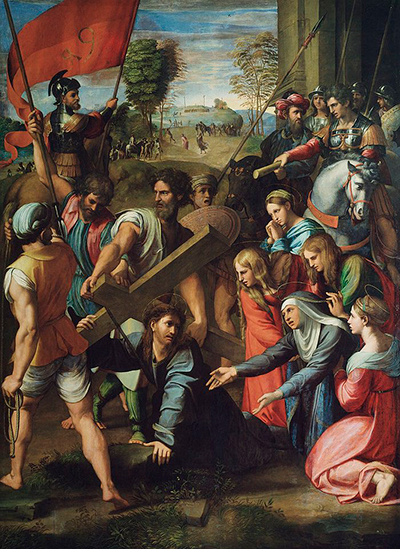Christ falling on the way to Calvary by Raphael was commissioned by Jacopo Basilio for the Monastery of Santa Maria dello Spasimo in Palermo
It is believed to have been painted between 1514-16. The dimensions of the painting are 318 cm by 229 cm and its type is oil on panel transferred to canvas.
The monastery is also referred to as the "Wonder of Sicily". It was founded to depict the grief and agony that Virgin Mary mother of Jesus went through as she witnessed the suffering of her son Jesus Christ. In a peculiar twist, the ship that was transporting the panting to Sicily went down and, but instead of the painting sinking with the ship, it drifted to the port of Genoa where monks found it and hailed the event as a miracle.
The King of Spain Philip IV bought it in 1622 before Napoleon took it to Paris as a booty in 1813. The painting was later brought back to Spain in 1822. It now rests in the hands of the Prado Museum (Museo del Prado) in Madrid, Spain.
Jesus is the main subject of the painting as it highlights the moment he slipped with the cross on his way to Golgotha for his crucifixion. In the painting there is a clear diagonal composition which converges to Christ. His mother the Virgin Mary is seen here suffering and weeping from agony as she tries to reach her hands towards him.
The path which Christ is to take is seen back into the picture where two crosses are already set up. However, he seems to move to the space on the left due to the accidental fall he suffered.
It widely regarded that the man on the left side was the same figure Raphael used in painting "The Judgement of Solomon," except that in this painting he is reversed. Simon of Cyrene can be seen trying to help Christ lift back the cross as he sternly looks at the guards. We can also see the four Mary's on the right side with the guards towering on either side of the painting.
Christ dominated art across the Renaissance, appearing frequently in many famous frescos and sculptures. Diego Velazquez's Christ Crucified is amongst the most powerful artwork, though Caravaggio gave us dramatic scenes in The Entombment of Christ, The Flagellation of Christ and Christ at the Column.
Notable sculptures include Risen Christ and Crucifix by Michelangelo.
In Catholicism, the concept of spasm was highly regarded yet one of the most controversial. However, in this painting, Virgin Mary is only seen on her knees and not collapsed or fainted as depicted in other paintings. As one of the talented painters during his time, it is widely believed that Raphael executed the painting in large measure by himself, with this painting considered one among his most adventuresome pieces.




